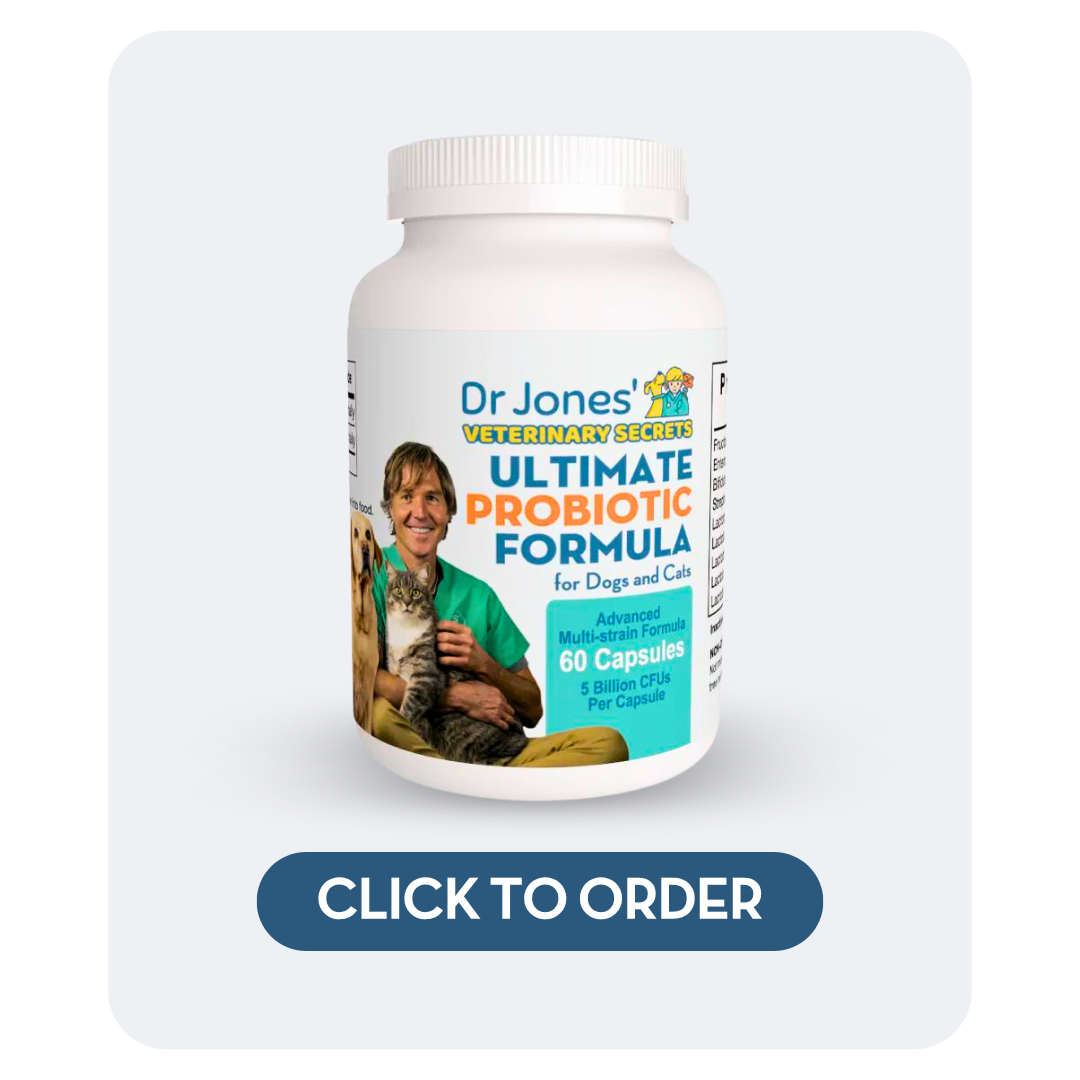The Real Reason Your Dog Is Scooting—Don’t Ignore THIS Warning Sign
![]()

When I first started out as a veterinary graduate, one of the less glamorous tasks that came with the job was expressing anal glands. As a new vet in a busy practice, this was often the go-to task for newbies like me—squeezing out the fishy-smelling contents from your dog’s anal glands. Trust me, it’s not as fun as it sounds.
But over time, I realized there are ways to prevent this situation, treat it more effectively, and even help mask that dreadful ‘fishy’ odor.
Why Anal Gland Issues Happen and How You Can Prevent Them
If your dog is experiencing recurring anal gland problems, you’re not alone. This issue can be frustrating for both you and your pet. The good news is that there are preventive steps you can take, and some treatments that can help reduce the need for this frequent (and often unpleasant) trip to the vet.
Probiotics and Enzymes: A Natural Solution
One of the solutions I found effective in practice is using probiotics, along with enzyme supplements. These can help regulate your dog’s digestive system, which may prevent the anal gland issues from popping up in the first place. If your dog suffers from chronic digestive issues or recurring anal gland problems, I highly recommend giving these a try.
Introducing Dr. Jones’ COMPLETE Digestive Care Soft Chews
To help combat anal gland issues, I developed Dr. Jones’ COMPLETE Digestive Care Soft Chews. These soft chews include both probiotics and enzyme supplements, formulated to improve your dog’s digestive health and overall comfort.
If you’re dealing with a persistent anal gland problem or digestive disorder in your dog, consider giving these chews a shot. They’re an easy, convenient way to address the issue from the inside out.
With the right care, you can minimize the need for frequent anal gland expression and help your dog feel more comfortable. Let’s take a natural, holistic approach to keeping your dog’s health in check!

What are Anal Glands in Dogs?
I often get questions about anal glands, so let’s dive into what they are and why they sometimes cause trouble for our furry friends.
The anal glands are two small pouches located near the anus—at about the four o’clock and eight o’clock positions. Inside these pouches are sebaceous glands that secrete a foul-smelling liquid with a characteristic “fishy" odor. This secretion is also known as the “scent gland.” Every time your dog defecates, some of the anal gland contents are expressed, leaving behind a “unique scent” that dogs use to mark their territory and identify each other. It’s all about the smell!
Why Do Dogs’ Anal Glands Fill Up and Need to Be Expressed?
The duct that connects the anal gland to the anus can become obstructed due to inflammation. Sometimes, the gland fluid thickens, making it harder for the glands to empty naturally.
When dogs can’t empty their anal glands properly, they can develop a variety of anal sac issues, such as:
-
Anal Gland Impaction: When the gland fluid becomes abnormal or can’t exit the glands, it builds up and causes pressure and inflammation.
-
Anal Gland Infections: If impaction is left untreated, it can lead to an infection. Bacteria from the anal area can travel down the canal and cause an infection.
-
Anal Gland Rupture: If an infection worsens, the gland can rupture, creating an open wound around the anus that may leak fluid, blood, or pus.
-
Anal Gland Tumors: In rare cases, dogs can develop cancer in the anal glands, which can spread to other parts of the body.
The most common issues I see are impacted or infected anal glands.
Symptoms of Anal Gland Problems in Dogs
If your dog is showing signs of anal gland issues, here’s what to watch for:
-
Scooting: This is when your dog drags their bottom on the carpet—probably the most common sign!
-
Fishy Odor: A noticeable fishy smell, especially around places where your dog often lies or sits.
-
Bump or Bulge: You may notice a bump or swelling near the anus.
-
Irritated Skin: Red, inflamed skin around the anus.
-
Discharge: Brown or red fluid leaking from the anal gland openings.
-
Excessive Licking: If your dog keeps licking the base of their tail.
-
Straining to Defecate: Your dog may have trouble passing stool.
-
Pain: If your dog cries out or whimpers during bowel movements, this could be a sign they are in pain.
-
Frequent Sitting: A dog who is constantly sitting down may be experiencing discomfort.
How to Prevent and Treat Anal Gland Problems at Home
If your dog’s defecation seems normal and there’s no visible redness, swelling, or discharge around the anus, then gland expression may be appropriate. If you’re unsure, don’t hesitate to consult your veterinarian.
Express the Glands Yourself
This may not be the most glamorous task, but it’s an effective way to relieve your dog’s discomfort. Here’s how:
-
First, take your pet to the bathtub and gently clean their bottom with lukewarm water.
-
Put on some latex gloves and lift your dog’s tail.
-
Place a paper towel behind their anus.
-
Gently squeeze the glands at both the four o’clock (right side) and eight o’clock (left side) positions. Apply moderate pressure.
-
If nothing comes out, adjust your angle and try again. You should notice a brownish, foul-smelling liquid being expressed.
-
Alternatively, you can squeeze over the anal glands directly.
Soak with Heat
Soak a washcloth in Epsom salts and warm water, and apply it to your dog’s bottom for about five minutes twice a day. You can also apply pressure to the glands while doing this, which can help them drain.
Bulk Up the Stool
Adding extra fiber to your dog’s diet helps increase stool volume, naturally applying pressure to the anal glands and aiding their expression. Some fiber-rich options include:
-
Ground flaxseed: 1 tsp per cup of food daily
-
Metamucil: 1 tsp per 10 lbs of body weight daily
-
Oat bran: 1 tsp per 10 lbs of body weight daily
-
Carrots: 1/8 cup per 10 lbs of body weight daily
-
Pumpkin: 1 tbsp daily (especially great for cats)
Exercise
Regular exercise can help with gland expression. Aim for at least 15 minutes of exercise twice daily.
Probiotics
Probiotics can help restore healthy bacteria in your pet’s intestines, boosting their immune system. A high-quality probiotic supplement like the one in Dr. Jones’ formulas is great for digestive health.
Allergies
Allergies can cause inflammation that blocks the duct and leads to anal gland obstruction. Some dogs respond well to enzyme supplements to alleviate this.
When to Call the Vet
If your dog’s anal glands remain obstructed after trying the above remedies, or if they appear abscessed, it’s time to call your vet. Your dog may need antibiotics or even surgery to resolve the issue.
Dealing with the Fishy Smell
If your dog is dealing with that unpleasant fishy odor, you can help freshen things up with an all-natural deodorizer:
-
Water: ½ cup
-
Apple Cider Vinegar: 2 tablespoons
-
Castile Soap: 1 teaspoon
-
Lavender Oil: 10 drops
Heal Your Pet at Home!
With the right care and a little patience, you can help your dog manage anal gland issues at home. I’ve had many clients who’ve learned how to express anal glands themselves—it’s not difficult and can save you both time and money.

P.S. Dr. Jones’ Complete Digestive Care Soft Chews are a tasty treat that will help your dog with digestive issues like food allergies, sensitivities, and even pancreatitis. With a blend of digestive enzymes and 2 billion CFUs of probiotics, these chews are a great way to support your dog’s health!








Do you have recommendations for cats? I’m sure this article applies to felines too. I have a cat who has leakages. He does cry out sometimes. The vet has recommended giving him pumpkin 1-2 teaspoons mixed in with his wet food per day. So far 1 tsp seems to irritate him and cause leakage. She also recommends using the supplement Glandex – Anal Gland Health which I will order. I feed my two cats turkey canned food from “Merrick” – Limited Ingredient Diet Grain Free – Real Turkey Recipe 2 cans per day (they split and a very minimal quantity of dry food by “Wellness Core – Grain Free Adult Cat “Deboned Turkey, Turkey Meal and Duck Recipe.
Thank you,
Ronda
Loki is the one having problems plus he is a licker and nervous. He had skin problems but cleared it up by keeping away from chicken. Thanks to you. Both have inflammation and pink underneath their skin. They were abandoned as four brothers at a lake.
Yes — many of the same principles in the article apply to cats. For feline anal-gland leakage, a gentle, low-fiber start is usually better since some cats get irritated by too much pumpkin. Instead of 1 tsp, try ?–¼ tsp pumpkin mixed into food and increase only if tolerated. The supplement Glandex for Cats is a reasonable option because it provides balanced fiber plus probiotics to help firm stool and support natural anal-gland emptying. Still, because your cat is crying and leaking, make sure your vet checks for impaction or infection, as supplements alone may not resolve those issues.
Check these articles:
https://veterinarysecrets.com/?s=feline%20anal%20gland